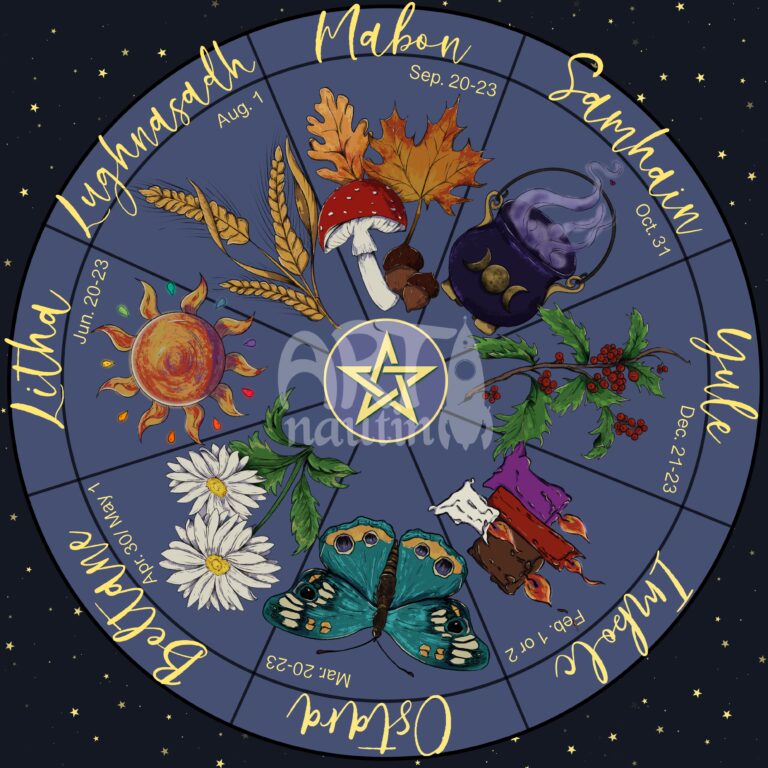
The Witch’s Wheel of the Year is a fascinating concept that forms the backbone of many modern pagan and witchcraft traditions. It is a cycle that represents the passage of time, the changing of the seasons, and the cyclical nature of life and death.
Samhain
Samhain, often considered the Witch’s New Year, is celebrated from October 31st to November 1st. It is a time when the veil between the physical world and the spirit world is believed to be the thinnest. This festival is often associated with honoring ancestors, introspection and divination. It is a time of transformation and inner work, like shadow work, where witches release what no longer serves them and prepare for the darker half of the year.
Yule
Yule, also known as the winter solstice, takes place around 21 December. It is the darkest night of the year and marks the return of light. Witches often celebrate Yule by burning a Yule log, decorating their homes with evergreen plants and performing rituals to welcome the return of light.
Imbolc
Imbolc, celebrated on February 1st or 2nd, marks the midpoint between the winter solstice and the spring equinox. It is traditionally a time of purification and cleansing, signifying the beginning of spring and the return of light. Witches often use this time to cleanse their homes and altars, perform divination, and dedicate themselves to personal growth and renewal.
Ostara
Ostara, also known as the spring equinox, takes place around 21 March. It marks the beginning of spring and a time of new beginnings and renewal. Witches often celebrate Ostara by painting eggs, planting seeds and performing rituals to celebrate the reawakening of nature.
Beltane
Beltane, celebrated on April 30th or May 1st, is a festival of fertility, abundance, and fire. It marks the midpoint between the spring equinox and the summer solstice, and it is a time of joy, growth, and passion. Bonfires are a common feature of Beltane celebrations, symbolizing the power of the sun and the fertility of the earth. Witches often perform rituals to attract abundance, find love, or strengthen existing relationships during this time.
Litha
The next festival on the Witch’s Wheel of the Year is Litha, more commonly known as the summer solstice. It takes place around June 21st and represents the peak of the sun’s power. This is the longest day and the shortest night of the year, symbolizing the triumph of light over darkness. Litha is a time of celebration, joy, and strength. Witches often celebrate by basking in the sun, making flower crowns, and holding feasts in honor of the sun’s abundance.
Lughnasadh
Lughnasadh, also known as Lammas, takes place on August 1st. It is the first of the three harvest festivals in the Wheel, marking the point where the first fruits are harvested and the hot summer days begin to wane. Traditionally, it’s a time of gratitude, abundance, and the start of the harvest season. Witches often celebrate this time by baking bread, holding feasts, and giving thanks for the abundance that the summer has provided.
Mabon
Mabon, or the autumn equinox, is the second of the three harvest festivals and takes place around September 21st. It is a time of balance, where day and night are of equal length. As the light recedes and we prepare for the winter, it’s a time to give thanks for the summer’s harvest and to prepare for the coming winter. Witches often celebrate Mabon by making wine, gathering herbs, and performing rituals of balance and harmony.
The Witch’s Wheel of the Year is a beautiful representation of the cyclical nature of life and the changing seasons. Each festival offers its unique energy and lessons. Whether it’s the introspection of Samhain, the renewal of Imbolc, the joy of Beltane, or the gratitude of Mabon, each turn of the wheel brings new opportunities for personal and spiritual growth.
May your journey through the Wheel of the Year be filled with wonder, wisdom, and magic.
